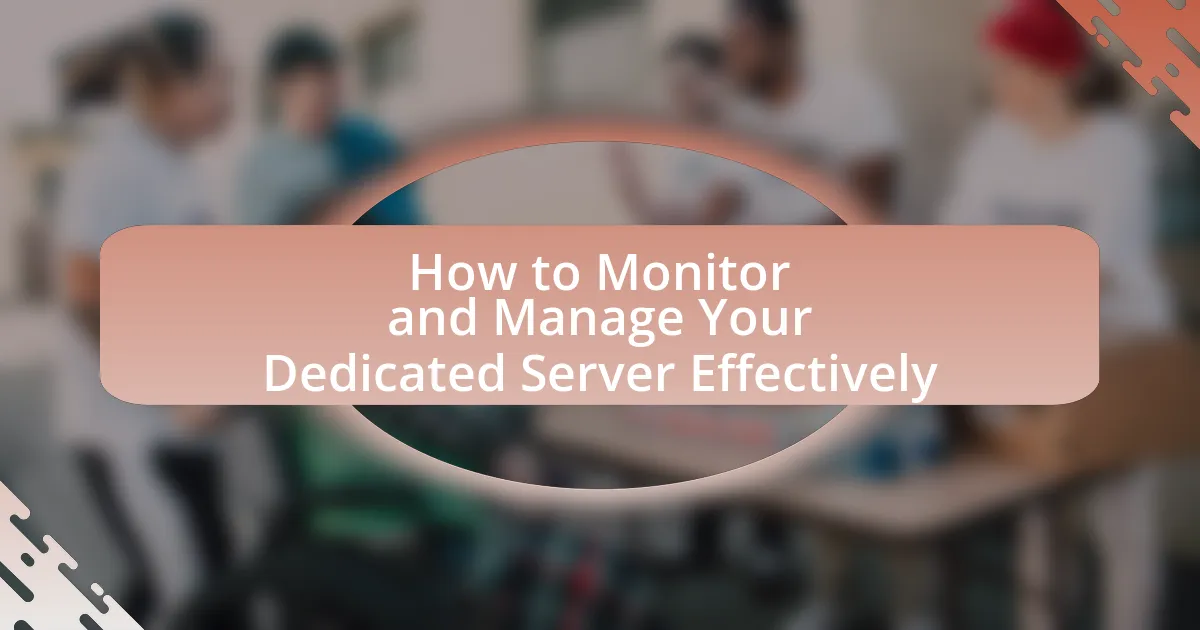A dedicated server is a physical server exclusively assigned to a single client, offering complete control over its resources, which is essential for optimal performance, security, and uptime. Monitoring dedicated servers is critical to detect hardware failures and security breaches early, significantly reducing downtime and enhancing reliability. The article outlines the differences between dedicated servers and other hosting types, key features, and the importance of proactive monitoring. It also discusses the risks of neglecting server monitoring, the impact of server downtime on businesses, and essential metrics to track for effective management. Additionally, it provides guidance on setting up monitoring tools, configuring alerts, and best practices for server maintenance to ensure optimal performance and security.

What is a Dedicated Server and Why is Monitoring Important?
A dedicated server is a physical server exclusively allocated to a single client, providing complete control over its resources, including CPU, RAM, and storage. Monitoring is crucial for dedicated servers because it ensures optimal performance, security, and uptime; for instance, regular monitoring can detect hardware failures or security breaches early, allowing for timely interventions. According to a study by the International Data Corporation, proactive monitoring can reduce downtime by up to 50%, highlighting its importance in maintaining server reliability and efficiency.
How does a dedicated server differ from other types of hosting?
A dedicated server differs from other types of hosting by providing exclusive access to all server resources for a single user or organization. Unlike shared hosting, where multiple users share the same server resources, or VPS hosting, which allocates a portion of server resources to multiple users, a dedicated server offers complete control over the server environment, including hardware, software, and security configurations. This exclusivity allows for enhanced performance, greater customization, and improved security, making dedicated servers ideal for high-traffic websites or applications that require reliable uptime and resource-intensive operations.
What are the key features of a dedicated server?
A dedicated server is characterized by its exclusive use of hardware resources, providing enhanced performance and control. Key features include full root access, allowing users to configure the server to their specific needs; high performance due to dedicated CPU, RAM, and storage; and improved security, as resources are not shared with other users. Additionally, dedicated servers offer customizable hardware options, enabling users to select components that best fit their requirements, and reliable uptime, often supported by service level agreements (SLAs) that guarantee availability. These features collectively ensure that dedicated servers are ideal for resource-intensive applications and high-traffic websites.
Why choose a dedicated server for your business?
A dedicated server is ideal for businesses because it provides exclusive resources, ensuring optimal performance and security. This exclusivity allows for higher reliability, as businesses do not share bandwidth or processing power with others, which can lead to faster load times and improved user experience. Additionally, dedicated servers offer enhanced security features, such as custom firewall configurations and dedicated IP addresses, which are crucial for protecting sensitive data. According to a study by HostingAdvice, businesses using dedicated servers report a 50% increase in performance compared to shared hosting solutions, highlighting the tangible benefits of this choice.
What are the risks of not monitoring your dedicated server?
Not monitoring your dedicated server exposes it to several significant risks, including security vulnerabilities, performance degradation, and potential data loss. Without regular oversight, malicious attacks can go undetected, leading to unauthorized access or data breaches. Additionally, unmonitored servers may experience resource exhaustion, resulting in slow response times or downtime, which can affect user experience and business operations. Furthermore, failure to monitor can lead to hardware failures going unnoticed, risking critical data loss and costly recovery efforts. According to a study by the Ponemon Institute, 60% of small businesses that experience a data breach go out of business within six months, underscoring the importance of proactive server monitoring.
How can server downtime impact your business?
Server downtime can significantly impact your business by causing revenue loss, damaging customer trust, and disrupting operations. For instance, a study by Gartner indicates that the average cost of IT downtime is approximately $5,600 per minute, which translates to substantial financial losses for businesses. Additionally, prolonged downtime can lead to a decrease in customer satisfaction, as clients may turn to competitors if they experience service interruptions. This erosion of trust can have long-term effects on brand loyalty and reputation. Furthermore, operational disruptions can hinder productivity, as employees may be unable to access necessary systems and data, leading to inefficiencies and delays in project timelines.
What security vulnerabilities can arise from poor monitoring?
Poor monitoring can lead to several security vulnerabilities, including undetected intrusions, data breaches, and prolonged exposure to threats. When monitoring systems fail to detect unusual activities, attackers can exploit vulnerabilities without being noticed, allowing them to access sensitive data or disrupt services. For instance, a study by the Ponemon Institute found that organizations with inadequate monitoring experienced data breaches that cost an average of $3.86 million. Additionally, poor monitoring can result in delayed incident response, increasing the potential damage from attacks. Therefore, effective monitoring is crucial to identify and mitigate security risks promptly.

How to Set Up Monitoring for Your Dedicated Server?
To set up monitoring for your dedicated server, install monitoring software such as Nagios, Zabbix, or Prometheus. These tools allow you to track server performance metrics like CPU usage, memory consumption, disk space, and network traffic in real-time. For example, Nagios can alert you to issues before they impact server performance, providing a proactive approach to server management. Additionally, configuring alerts and notifications ensures that you are promptly informed of any anomalies, allowing for quick resolution.
What tools are available for monitoring dedicated servers?
Tools available for monitoring dedicated servers include Nagios, Zabbix, and Prometheus. Nagios provides comprehensive monitoring capabilities for server performance and availability, allowing administrators to receive alerts on issues. Zabbix offers real-time monitoring and visualization of server metrics, enabling proactive management. Prometheus is designed for monitoring dynamic cloud environments, collecting metrics through a powerful query language. These tools are widely used in the industry, demonstrating their effectiveness in ensuring server reliability and performance.
How do server monitoring tools work?
Server monitoring tools work by continuously tracking the performance and health of servers through various metrics such as CPU usage, memory consumption, disk space, and network activity. These tools collect data in real-time, allowing system administrators to identify issues, optimize performance, and ensure uptime. For instance, tools like Nagios and Zabbix utilize agents installed on servers to gather this data, which is then analyzed and presented through dashboards for easy interpretation. This process enables proactive management, as alerts can be configured to notify administrators of potential problems before they escalate, thereby maintaining server reliability and efficiency.
What features should you look for in a monitoring tool?
When selecting a monitoring tool, you should look for features such as real-time monitoring, alerting capabilities, performance metrics, and user-friendly dashboards. Real-time monitoring allows for immediate detection of issues, while alerting capabilities ensure that you are notified of critical events promptly. Performance metrics provide insights into server health, including CPU usage, memory consumption, and disk space, which are essential for maintaining optimal performance. User-friendly dashboards facilitate easy interpretation of data, enabling quick decision-making. These features collectively enhance the effectiveness of monitoring and managing dedicated servers.
How can you configure alerts and notifications?
To configure alerts and notifications, access the server management interface and navigate to the alerts section. In this section, you can set specific criteria for triggering alerts, such as CPU usage thresholds, memory usage, or disk space limits. Additionally, you can specify notification methods, including email, SMS, or integration with third-party monitoring tools. This process ensures that you receive timely updates on server performance and potential issues, allowing for proactive management.
What types of alerts are essential for server management?
Essential alerts for server management include performance alerts, security alerts, and availability alerts. Performance alerts monitor CPU usage, memory consumption, and disk space to ensure optimal server operation. Security alerts detect unauthorized access attempts, malware activity, and vulnerabilities, which are critical for maintaining server integrity. Availability alerts notify administrators of downtime or service interruptions, enabling prompt response to minimize impact. These alerts are vital for proactive server management, ensuring reliability and security in dedicated server environments.
How can you customize alert settings for your needs?
You can customize alert settings by accessing the server management interface and adjusting the notification preferences according to your specific requirements. This typically involves selecting the types of events you want to be alerted about, such as CPU usage, memory usage, or disk space thresholds, and specifying the delivery method, which may include email, SMS, or in-app notifications. Many server management tools also allow you to set thresholds for alerts, ensuring you receive notifications only when certain conditions are met, thus tailoring the alert system to your operational needs.

What Metrics Should You Monitor on Your Dedicated Server?
You should monitor CPU usage, memory usage, disk I/O, network traffic, and server uptime on your dedicated server. CPU usage indicates how much processing power is being utilized, with optimal levels typically below 70% to ensure performance. Memory usage reflects the amount of RAM in use, where high usage can lead to slowdowns; monitoring should aim to keep usage below 80%. Disk I/O measures read and write operations, and excessive I/O can indicate bottlenecks, necessitating monitoring for optimal performance. Network traffic assesses the data being sent and received, with spikes potentially indicating issues or attacks; maintaining traffic within expected ranges is crucial. Lastly, server uptime is essential for reliability, with monitoring tools often aiming for 99.9% uptime to ensure service availability.
Which performance metrics are critical for server health?
Critical performance metrics for server health include CPU usage, memory usage, disk I/O, network latency, and uptime. CPU usage indicates how much processing power is being utilized, with optimal levels typically below 70-80% to prevent bottlenecks. Memory usage reflects the amount of RAM in use; consistently high usage can lead to performance degradation. Disk I/O measures the read and write speeds of storage devices, essential for assessing data access efficiency. Network latency tracks the time it takes for data to travel across the network, with lower values indicating better performance. Uptime is a measure of server availability, with higher percentages indicating better reliability. Monitoring these metrics helps ensure optimal server performance and early detection of potential issues.
How do CPU and memory usage affect server performance?
CPU and memory usage directly impact server performance by determining how efficiently a server can process tasks and manage data. High CPU usage can lead to slower processing times and increased latency, as the server struggles to handle multiple requests simultaneously. Similarly, insufficient memory can cause excessive swapping between RAM and disk storage, resulting in slower data access and application performance. For instance, a study by the University of California, Berkeley, found that servers operating at over 80% CPU utilization experienced a significant drop in response times, highlighting the critical balance needed for optimal performance.
What role does disk space and I/O performance play?
Disk space and I/O performance are critical for the efficient operation of a dedicated server. Adequate disk space ensures that applications and data can be stored without interruption, while optimal I/O performance affects the speed at which data is read from and written to the disk. For instance, servers with insufficient disk space may experience slowdowns or failures in application performance, as they cannot accommodate necessary data. Additionally, high I/O performance, measured in operations per second (IOPS), directly influences the responsiveness of applications; a study by Storage Performance Council indicates that higher IOPS can significantly reduce latency and improve user experience. Thus, both disk space and I/O performance are essential for maintaining server reliability and efficiency.
How can you monitor network performance effectively?
To monitor network performance effectively, utilize network monitoring tools that provide real-time data on bandwidth usage, latency, and packet loss. Tools such as SolarWinds, PRTG Network Monitor, and Wireshark can analyze traffic patterns and identify bottlenecks. For instance, SolarWinds offers a comprehensive dashboard that visualizes network performance metrics, allowing administrators to pinpoint issues quickly. According to a study by the International Journal of Computer Applications, effective monitoring can reduce downtime by up to 50%, highlighting the importance of proactive network management.
What tools can help you analyze network traffic?
Wireshark is a powerful tool that can help you analyze network traffic. It captures and displays data packets in real-time, allowing users to inspect the details of network communications. Additionally, tools like tcpdump provide command-line packet analysis, while SolarWinds Network Performance Monitor offers comprehensive monitoring and reporting features. These tools are widely used in network management to troubleshoot issues, optimize performance, and ensure security.
How do latency and bandwidth impact server operations?
Latency and bandwidth significantly impact server operations by affecting data transmission speed and capacity. High latency results in delays in data packets reaching their destination, which can slow down application performance and user experience. For instance, a latency of 100 milliseconds can lead to noticeable lag in real-time applications like gaming or video conferencing. Conversely, bandwidth determines the amount of data that can be transmitted over a network in a given time frame; insufficient bandwidth can lead to bottlenecks, causing slow loading times and reduced throughput. For example, a server with a bandwidth of 10 Mbps may struggle to handle multiple simultaneous users, leading to degraded performance. Therefore, optimizing both latency and bandwidth is crucial for maintaining efficient server operations and ensuring a seamless user experience.

How to Manage Your Dedicated Server Based on Monitoring Insights?
To manage your dedicated server based on monitoring insights, regularly analyze performance metrics such as CPU usage, memory consumption, and disk I/O. This analysis allows for timely adjustments to resource allocation, ensuring optimal performance. For instance, if CPU usage consistently exceeds 80%, consider upgrading the server’s CPU or optimizing running applications to reduce load. Additionally, monitoring network traffic can identify potential bottlenecks, enabling proactive measures like bandwidth upgrades or load balancing. Implementing automated alerts for critical thresholds ensures immediate action can be taken, minimizing downtime and maintaining service reliability.
What are the best practices for server maintenance?
The best practices for server maintenance include regular software updates, consistent backups, monitoring system performance, and ensuring security measures are in place. Regular software updates prevent vulnerabilities by patching known security flaws, which is crucial as 60% of breaches are linked to unpatched software. Consistent backups protect data integrity, allowing recovery in case of hardware failure or cyberattacks; the 3-2-1 backup rule—three copies of data, on two different media, with one off-site—is widely recommended. Monitoring system performance through tools like Nagios or Zabbix helps identify issues before they escalate, with studies showing proactive monitoring can reduce downtime by up to 50%. Lastly, implementing security measures such as firewalls, intrusion detection systems, and regular security audits is essential, as 43% of cyberattacks target small businesses.
How often should you perform server updates and patches?
Server updates and patches should be performed at least once a month. Regular monthly updates help ensure that security vulnerabilities are addressed promptly, as many cyber threats exploit outdated software. According to the National Institute of Standards and Technology (NIST), timely application of patches is critical for maintaining system integrity and security. Additionally, organizations may need to apply critical updates immediately upon release, especially if they address severe vulnerabilities. This proactive approach minimizes the risk of security breaches and system failures.
What routine checks should be part of your management plan?
Routine checks that should be part of your management plan for effectively monitoring and managing a dedicated server include system performance monitoring, security audits, backup verification, and software updates. System performance monitoring involves regularly checking CPU usage, memory usage, and disk space to ensure optimal operation. Security audits should be conducted to identify vulnerabilities and ensure compliance with security policies. Backup verification ensures that data is being backed up correctly and can be restored when needed. Software updates are crucial for maintaining security and functionality, as they often include patches for known vulnerabilities. These checks are essential for maintaining server health and security, as evidenced by industry best practices that emphasize proactive management to prevent downtime and data loss.
How can you troubleshoot common server issues?
To troubleshoot common server issues, first identify the symptoms, such as slow performance or downtime. Next, check server logs for errors, which can provide insights into the underlying problems. Additionally, verify network connectivity and ensure that all services are running as expected. Use monitoring tools to analyze resource usage, such as CPU, memory, and disk space, to pinpoint bottlenecks. Regularly updating software and applying patches can also prevent issues. According to a study by the International Journal of Computer Applications, proactive monitoring can reduce server downtime by up to 50%, highlighting the importance of these troubleshooting steps.
What steps should you take when performance drops?
When performance drops on a dedicated server, the first step is to identify the cause of the decline. This can be achieved by monitoring system metrics such as CPU usage, memory consumption, disk I/O, and network traffic. Tools like top, htop, or server monitoring software can provide real-time insights into these metrics.
Next, evaluate running processes to determine if any applications are consuming excessive resources. For instance, if a specific application is identified as a resource hog, consider optimizing its configuration or updating it to a more efficient version.
Additionally, check for hardware issues, such as failing disks or insufficient RAM, which can contribute to performance degradation. Running diagnostic tools can help identify these hardware problems.
If the server is under heavy load, consider scaling resources by upgrading hardware or optimizing server configurations to better handle the traffic. Implementing load balancing can also distribute traffic more evenly across multiple servers, improving overall performance.
Regular maintenance, such as clearing cache and temporary files, can also help restore performance levels. Lastly, reviewing server logs can provide insights into errors or warnings that may indicate underlying issues affecting performance.
How can you identify and resolve security breaches?
To identify and resolve security breaches, implement a multi-layered approach that includes continuous monitoring, threat detection, and incident response protocols. Continuous monitoring involves using tools such as intrusion detection systems (IDS) and security information and event management (SIEM) solutions to analyze network traffic and system logs for unusual activities. For instance, according to a 2021 report by IBM, organizations that utilize automated security monitoring can detect breaches 27% faster than those that do not.
Once a potential breach is identified, conduct a thorough investigation to assess the extent of the breach, which includes analyzing affected systems and data. Following this, initiate an incident response plan that outlines steps for containment, eradication, and recovery. The National Institute of Standards and Technology (NIST) provides a framework for incident response that emphasizes preparation, detection, analysis, containment, eradication, and recovery, ensuring a structured approach to resolving security incidents.
What are some tips for optimizing server performance?
To optimize server performance, implement resource monitoring, load balancing, and regular updates. Resource monitoring allows for real-time tracking of CPU, memory, and disk usage, enabling proactive management of bottlenecks. Load balancing distributes incoming traffic across multiple servers, enhancing responsiveness and minimizing downtime. Regular updates to the operating system and software ensure security patches and performance improvements are applied, which is crucial as outdated systems can lead to vulnerabilities and inefficiencies. According to a study by the International Journal of Computer Applications, effective resource management can improve server performance by up to 50%.
How can resource allocation improve server efficiency?
Resource allocation can improve server efficiency by optimizing the distribution of computing resources such as CPU, memory, and storage to meet workload demands. When resources are allocated based on real-time usage patterns, servers can minimize idle time and maximize throughput, leading to better performance. For instance, studies show that dynamic resource allocation can increase server utilization rates by up to 30%, as it allows for the adjustment of resources in response to varying application needs. This targeted approach not only enhances performance but also reduces operational costs by ensuring that resources are not over-provisioned or underutilized.
What role does load balancing play in server management?
Load balancing is crucial in server management as it distributes incoming network traffic across multiple servers, ensuring no single server becomes overwhelmed. This distribution enhances the responsiveness and availability of applications, leading to improved user experience. According to a study by the International Journal of Computer Applications, effective load balancing can increase server utilization by up to 80%, thereby optimizing resource use and minimizing downtime. By preventing server overload, load balancing also contributes to fault tolerance, as traffic can be rerouted to healthy servers in case of failure, ensuring continuous service availability.


